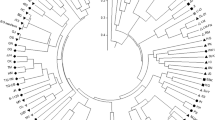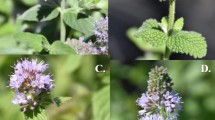Abstract
The round melon Praecitrullus fistulosus (Stocks) Pangalo has been cultivated in Asia since ancient times and has been considered an underexploited crop in the western world. In the USA, there is an increased interest in using P. fistulosus as a commercial vegetable, and possibly as a rootstock for grafting watermelon, melon, or cucumber. However, the taxonomic classification of P. fistulosus is incomplete and for many years it has been considered a close relative of watermelon [Citrullus lanatus subsp. vulgaris (Schrad. ex Eckl. et Zeyh.) Fursa] and was previously classified as Citrullus lanatus subsp. fistulosus (Stocks) Duthie et J.B. Fuller. Here, we used two sets of DNA markers to assess the genetic similarity of P. fistulosus in relation to Citrullus spp. {including Citrullus lanatus subsp. vulgaris, C. lanatus subsp. lanatus, Citroides group [also known as C. lanatus (Thunb.) Matsum. et Nakai subsp. lanatus var. citroides (Bailey) Mansf. ex Greb.], and C. colocynthis (L.) Schrad.}, Cucumis spp. (including C. melo, C. sativus, C. anguria, C. meeusei, C. zeyheri), Benincasa hispida (Thunb.) Cogn., Lagenaria siceraria (Mol.) Standl. and Cucurbita spp. (including C. moschata Duchesne and the winter squash C. maxima Duchesne). The first marker set comprised 501 markers that were produced by 38 primer pairs derived from watermelon expressed sequenced tags (ESTs) containing simple sequence repeat (SSR) motifs (designated as EST-SSR primers; produced 311 markers), and by 18 primer pairs derived from ESTs that do not contain SSR motives (designated here as EST-PCR primers; produced 190 markers). The second marker set comprised 628 markers that were produced by 18 sequence related amplified polymorphism (SRAP) primer pairs. The phylogenetic data indicated that among these cucurbit species, the wax gourd B. hispida is the closest to the P. fistulosus. Pollen observations, using light microscopy, indicated that each of the cucurbit genera examined here has unique pollen morphology. The Cucurbita spp. have globular pollen grains with a stigmatic surface. The L. siceraria has polygonal pollen grains with symmetrical boundaries, while the Citrullus spp. and Cucumis spp. have ovular (conical) and triangular shaped pollen grains (respectively). The B. hispida and P. fistulosus have spherical or semispherical pollen grains. These pollen features appear to be in agreement with the phylogenetic relationships of these two species based on DNA markers. Analysis with 12 SRAP primer pairs revealed low genetic diversity among 18 United States Plant Introductions (PIs) of P. fistulosus, indicating the need to expand the germplasm collection of this cucurbit crop.



Similar content being viewed by others
References
Achigan-Dako GE (2008) Phylogenetic and genetic variation analyses in cucurbit species (Cucurbitaceae) from West Africa: definition of conservation strategies. Cuvillier Verlag, Göttingen 154 p
Chen Y-C, Eisner JD, Kattar MM, Rassoulian-Barrett SL, Lafe K, Limaye AP, Cookson BT (2001) Polymorphic internal transcribed spacer region 1 DNA sequences identify medically important yeasts. J Clin Microbiol 39:4042–4051
Cohen R, Burger Y, Horev C, Koren A, Edelstein M (2007) Introducing grafted cucurbits to modern agriculture: the Israeli experience. Plant Dis 91:916–923
Dane F, Lang P (2004) Sequence variation at cpDNA regions of watermelon and related wild species: implications for the evolution of Citrullus haplotypes. Am J Bot 91:1922–1929
Davis AR, Levi A, Tetteh A, Wehner T, Russo VM, Pitrat M (2007) Evaluation of watermelon and related species for resistance to race 1 W powdery mildew resistance. J Am Soc Hort Sci 132:790–795
Decker-Walters DS, Chung SM, Staub JE (2004a) Chloroplast sequence evolution: a new pattern of nucleotide substitutions in the Cucurbitaceae. J Mol Evol 58:606–614
Decker-Walters DS, Wilkins-Ellert M, Chung SM, Staub JE (2004b) Discovery and genetic assessment of wild bottle gourd [Lagenaria siceraria (Mol.) Standley; Cucurbitaceae] from Zimbabwe. Econ Bot 58:501–508
Edlund AF, Swanson R, Preuss D (2004) Pollen and stigma structure and function: the role of diversity in pollination. Plant Cell 16:S84–S97
Hileman LC, Cubas P (2009) An expanded evolutionary role for flower symmetry genes. J Biol 8:90
Hopkins DL, Levi A (2008) Progress in the development of Crimson Sweet-type watermelon breeding lines with resistance to Acidovorax avenae subsp. citrulli. In: Pitrat M (ed) Cucurbitaceae 2008. Proceedings of the IXth EUCARPIA meeting on genetics and breeding of Cucurbitaceae, Avignon (France), pp. 157–162
Jarret RL, Merrick LC, Holms T, Evans J, Aradhya MK (1997) Simple sequence repeats in watermelon (Citrullus lanatus (Thunb.) Matsum. & Nakai). Genome 40:433–441
Khoshoo TN, Vij SP (1963) Biosystematics of Citrullus vulgaris var. fistulosus. Caryologia 16:541–552
Kirchoff BK, Pfeifer E, Rutishauser R (2008) Plant structure ontology: how should we label plant structures with doubtful or mixed identities? Zootaxa 1950:103–122
Kirkbride JH Jr (1993) Biosystematic monograph of the genus Cucumis (Cucurbitaceae). Parkway Publishers, Boone
Kocyan A, Zhang L-B, Schaefer H, Renner SS (2007) A multi-locus chloroplast phylogeny for the Cucurbitaceae and its implications for character evolution and classification. Mol Phyl Evol 44:553–577
Kuriachan P, Beevy SS (1992) Occurrence and chromosome number of Cucumis sativus var. hardwickii (Royle) Alef. in South India and its bearing on the origin of cultivated cucumber. Euphytica 61:131–133
Laghetti G, Hammer K (2007) The Corsican citron melon (Citrullus lanatus (Thunb.) Matsum. et Nakai subsp. lanatus var. citroides (Bailey) Mansf. ex Greb.) a traditional and neglected crop. Genet Resour Crop Evol 54:913–916
Levi A, Thomas CE (1999) An improved procedure for isolation of high quality DNA from watermelon and melon leaves. Cucurbit Genet Coop Rep 22:41–42
Levi A, Thomas CE, Keinath AP, Wehner TC (2001) Genetic diversity among watermelon (Citrullus lanatus and Citrullus colocynthis) accessions. Genet Resour Crop Ev 48:559–566
Levi A, Thomas CE, Simmons AM, Thies JA (2005) Analysis based on RAPD and SSR markers reveals closer similarities among Citrullus and Cucumis species than with Praecitrullus fistulosus (Stocks) Pangalo. Genet Resour Crop Evol 52:463–470
Levi A, Thomas CE, Trebitsh T, Salman A, King J, Karalius J, Newman M, Reddy OUK, Xu Y, Zhang Z (2006a) An extended linkage map for watermelon based on SRAP, AFLP, SSR, ISSR, and RAPD Markers. J Am Soc Hort Sci 131:393–402
Levi A, Davis A, Hernandez A, Wechter P, Thimmapuram J, Tadmor Y, Katzir N, Trebitsh T, King S (2006b) Genes expressed during the development and ripening of watermelon fruit. Plant Cell Rep 25:1233–1245
Levi A, Wechter P, Davis A (2009) EST-PCR markers representing watermelon fruit genes are polymorphic among watermelon heirloom cultivars sharing a narrow genetic base. Plant Genet Res 7:16–32
Li G, Quiros CF (2001) Sequence-related amplified polymorphism (SRAP), a new marker system based on a simple PCR reaction: its application to mapping and gene tagging in Brassica. Theor Appl Genet 103:455–461
Lloyd A, Walbot V, Davis RW (1992) Arabidopsis and Nicotiana anthocyanin production activated by maize regulators R and Cl. Science 258:1773–1775
Mantel N (1967) The detection of disease clustering and a generalized regression approach. Cancer Res 27:209–220
Marr KL, Xia Y, Bhattarai NK (2007) Allozymic, morphological, phenological, linguistic, plant use, and nutritional data of Benincasa hispida (Cucurbitaceae). Econ Bot 61:44–59
Nei M, Li W (1979) Mathematical model for studying genetic variation in terms of restriction endonucleases. Proc Natl Acad Sci USA 76:5269–5273
Pangalo KI (1938) Living ancestors of cultivated watermelon. C.R. (Doklady) Acad Sci URSS 10:599–600
Pavlicek A, Hrda S, Flegr J (1999) FreeTree-Freeware program for construction of phylogenetic trees on the basis of distance data and bootstrap/jackknife analysis of the tree robustness. Application in the RAPD analysis of the genus Frenkelia. Folia Biol (Praha) 45:97–99
Pina C, Pinto F, Feijó JA, Becker JD (2005) Gene family analysis of the Arabidopsis pollen transcriptome reveals biological implications for cell growth, division control, and gene expression regulation. Plant Physiol 138:744–756
Preston JC, Hileman LC (2009) Developmental genetics of floral symmetry evolution. Trends Plant Sci 14:147–154
Renner SS, Schaefer H, Kocyan A (2007) Phylogenetics of Cucumis (Cucurbitaceae): cucumber (C. sativus) belongs in an Asian/Australian clade far from melon (C. melo). BMC Evol Biol 7:58
Rohlf FJ (1998) NTSYS-pc version 2.02j. Numerical taxonomy and multivariate analysis system. Exeter software, Setauket
Schaefer H, Heibl C, Renner SS (2009) Gourds afloat: a dated phylogeny reveals an Asian origin of the gourd family (Cucurbitaceae) and numerous oversea dispersal events. Proc R Soc Biol Sci 276:843–851
Shimotsuma M (1960) Cytogenetical studies in the genus Citrullus, V. chromosome conjugation and fertility in induced autotetraploids. Jpn J Genet 36:63–71
Shimotsuma M (1961) Chromosome number of Citrullus species, vol 2. Chromosome Information Service, Tokyo, pp 14–16
Shimotsuma M (1963) Cytogenetics and evolutionary studies in the genus Citrullus. Seiken Ziho 15:23–24
Simmons AM, Levi A (2002) Evaluation of watermelon germplasm for resistance to Bemisia. In: Maynard DN (ed) Cucurbitacea. American Society of Horticultural Science, Alexandria, pp 282–286
Singh DK (2007) Cucurbits. In: Peter KV (ed) Underutilized and underexploited horticultural crops, vol 2. New India Publishing Agency, New Delhi, pp 175–193
Sokal RR, Rohlf FJ (1962) The comparison of dendrograms by objective methods. Taxon 11:33–40
Sporne KR (2006) Some observations on the evolution of pollen in dicotyledons. New Phytol 71:181–185
Sujatha VS, Seshadri VS (1989) Taxonomic position of round melon (Praecitrullus fistulosus). Cucurbit Genet Coop Rep 12:86–88
Wang BB, O’Toole M, Brendel V, Young ND (2008) Cross-species EST alignments reveal novel and conserved alternative splicing events in legumes. BMC Plant Biol 8:17
Wechter WP, Levi A, Harris KR, Davis AR, Fei ZJ, Katzir N, Giovannoni JJ, Salman A, Hernandez A, Thimmapuram J, Tadmor V, Portnoy V, Trebitsh T (2008) Gene expression in developing watermelon fruit. BMC Genomics 9:275–282
Whitaker TW (1932) Cytological and phylogenetic studies in the Cacurbitaceae. Bot Gaz 94:780–790
Whitaker TW (1947) American origin of the cultivated cucurbits. Ann Missouri Bot Gard 34:101–111
Wolfe KH, Sharp PM, Li W-H (1989) Rates of synonymous substitution in plant nuclear genes. J Mol Evol 29:208–211
Xu YH, Fei Y, You-Lin C, Lu M, Jian-Bo W, Li-Jia L (2007) Comparative analysis of rDNA distribution in metaphase chromosomes of Cucurbitaceae species. Hereditas (Beijing) 29:614–620
Acknowledgments
The use of trade names in this publication does not imply endorsement by the USDA of the products named, or criticism of similar ones not mentioned. The authors thank Laura Pence for her excellent technical assistance and Dr. Merle Shepard for photographing the cucurbit plants in this study and for his critical review of this manuscript.
Author information
Authors and Affiliations
Corresponding author
Rights and permissions
About this article
Cite this article
Levi, A., Harris, K.R., Wechter, W.P. et al. DNA markers and pollen morphology reveal that Praecitrullus fistulosus is more closely related to Benincasa hispida than to Citrullus spp.. Genet Resour Crop Evol 57, 1191–1205 (2010). https://doi.org/10.1007/s10722-010-9559-3
Received:
Accepted:
Published:
Issue Date:
DOI: https://doi.org/10.1007/s10722-010-9559-3




